Gennady Pekhimenko
DPQuant: Efficient and Differentially-Private Model Training via Dynamic Quantization Scheduling
Sep 03, 2025Abstract:Differentially-Private SGD (DP-SGD) is a powerful technique to protect user privacy when using sensitive data to train neural networks. During training, converting model weights and activations into low-precision formats, i.e., quantization, can drastically reduce training times, energy consumption, and cost, and is thus a widely used technique. In this work, we demonstrate that quantization causes significantly higher accuracy degradation in DP-SGD compared to regular SGD. We observe that this is caused by noise injection in DP-SGD, which amplifies quantization variance, leading to disproportionately large accuracy degradation. To address this challenge, we present QPQuant, a dynamic quantization framework that adaptively selects a changing subset of layers to quantize at each epoch. Our method combines two key ideas that effectively reduce quantization variance: (i) probabilistic sampling of the layers that rotates which layers are quantized every epoch, and (ii) loss-aware layer prioritization, which uses a differentially private loss sensitivity estimator to identify layers that can be quantized with minimal impact on model quality. This estimator consumes a negligible fraction of the overall privacy budget, preserving DP guarantees. Empirical evaluations on ResNet18, ResNet50, and DenseNet121 across a range of datasets demonstrate that DPQuant consistently outperforms static quantization baselines, achieving near Pareto-optimal accuracy-compute trade-offs and up to 2.21x theoretical throughput improvements on low-precision hardware, with less than 2% drop in validation accuracy.
Tilus: A Virtual Machine for Arbitrary Low-Precision GPGPU Computation in LLM Serving
Apr 25, 2025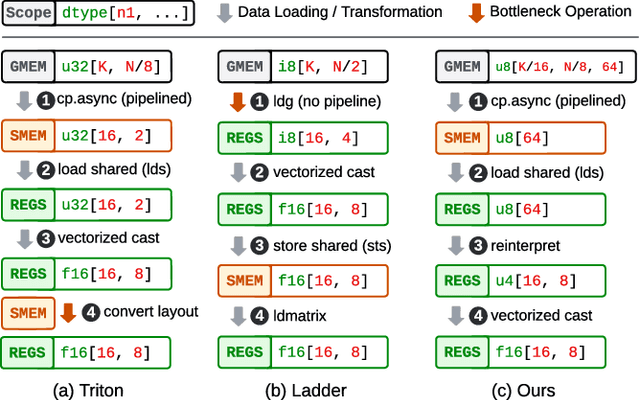
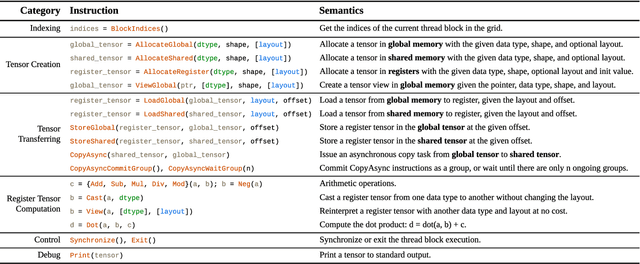
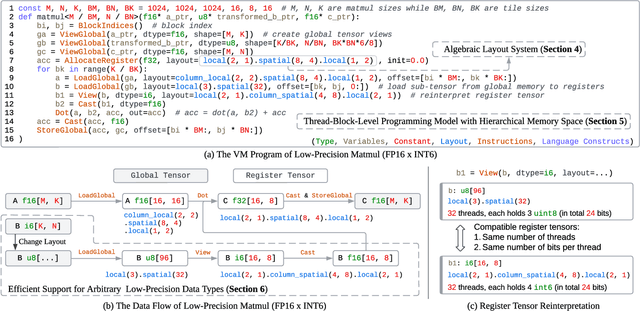
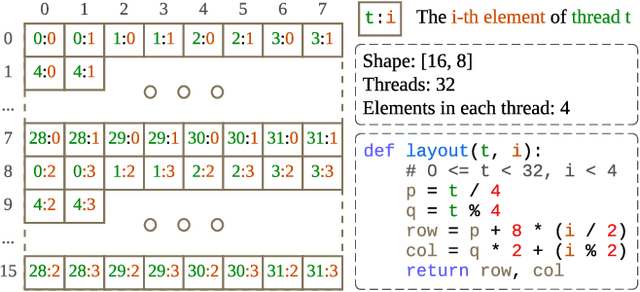
Abstract:Serving Large Language Models (LLMs) is critical for AI-powered applications but demands substantial computational resources, particularly in memory bandwidth and computational throughput. Low-precision computation has emerged as a key technique to improve efficiency while reducing resource consumption. Existing approaches for generating low-precision kernels are limited to weight bit widths that are powers of two and suffer from suboptimal performance due to high-level GPU programming abstractions. These abstractions restrict critical optimizations, such as fine-grained register management and optimized memory access patterns, which are essential for efficient low-precision computations. In this paper, we introduce a virtual machine (VM) designed for General-Purpose GPU (GPGPU) computing, enabling support for low-precision data types with arbitrary bit widths while maintaining GPU programmability. The proposed VM features a thread-block-level programming model, a hierarchical memory space, a novel algebraic layout system, and extensive support for diverse low-precision data types. VM programs are compiled into highly efficient GPU programs with automatic vectorization and instruction selection. Extensive experiments demonstrate that our VM efficiently supports a full spectrum of low-precision data types, and outperforms state-of-the-art low-precision kernels on their supported types. Compared to existing compilers like Triton and Ladder, as well as hand-optimized kernels such as QuantLLM and Marlin, our VM achieves performance improvements of 1.75x, 2.61x, 1.29x and 1.03x, respectively.
Hexcute: A Tile-based Programming Language with Automatic Layout and Task-Mapping Synthesis
Apr 22, 2025Abstract:Deep learning (DL) workloads mainly run on accelerators like GPUs. Recent DL quantization techniques demand a new matrix multiplication operator with mixed input data types, further complicating GPU optimization. Prior high-level compilers like Triton lack the expressiveness to implement key optimizations like fine-grained data pipelines and hardware-friendly memory layouts for these operators, while low-level programming models, such as Hidet, Graphene, and CUTLASS, require significant programming efforts. To balance expressiveness with engineering effort, we propose Hexcute, a tile-based programming language that exposes shared memory and register abstractions to enable fine-grained optimization for these operators. Additionally, Hexcute leverages task mapping to schedule the GPU program, and to reduce programming efforts, it automates layout and task mapping synthesis with a novel type-inference-based algorithm. Our evaluation shows that Hexcute generalizes to a wide range of DL operators, achieves 1.7-11.28$\times$ speedup over existing DL compilers for mixed-type operators, and brings up to 2.91$\times$ speedup in the end-to-end evaluation.
A Virtual Machine for Arbitrary Low-Precision GPGPU Computation in LLM Serving
Apr 17, 2025



Abstract:Serving Large Language Models (LLMs) is critical for AI-powered applications but demands substantial computational resources, particularly in memory bandwidth and computational throughput. Low-precision computation has emerged as a key technique to improve efficiency while reducing resource consumption. Existing approaches for generating low-precision kernels are limited to weight bit widths that are powers of two and suffer from suboptimal performance due to high-level GPU programming abstractions. These abstractions restrict critical optimizations, such as fine-grained register management and optimized memory access patterns, which are essential for efficient low-precision computations. In this paper, we introduce a virtual machine (VM) designed for General-Purpose GPU (GPGPU) computing, enabling support for low-precision data types with arbitrary bit widths while maintaining GPU programmability. The proposed VM features a thread-block-level programming model, a hierarchical memory space, a novel algebraic layout system, and extensive support for diverse low-precision data types. VM programs are compiled into highly efficient GPU programs with automatic vectorization and instruction selection. Extensive experiments demonstrate that our VM efficiently supports a full spectrum of low-precision data types, and outperforms state-of-the-art low-precision kernels on their supported types. Compared to existing compilers like Triton and Ladder, as well as hand-optimized kernels such as QuantLLM and Marlin, our VM achieves performance improvements of 1.75x, 2.61x, 1.29x and 1.03x, respectively.
Mist: Efficient Distributed Training of Large Language Models via Memory-Parallelism Co-Optimization
Mar 24, 2025Abstract:Various parallelism, such as data, tensor, and pipeline parallelism, along with memory optimizations like activation checkpointing, redundancy elimination, and offloading, have been proposed to accelerate distributed training for Large Language Models. To find the best combination of these techniques, automatic distributed training systems are proposed. However, existing systems only tune a subset of optimizations, due to the lack of overlap awareness, inability to navigate the vast search space, and ignoring the inter-microbatch imbalance, leading to sub-optimal performance. To address these shortcomings, we propose Mist, a memory, overlap, and imbalance-aware automatic distributed training system that comprehensively co-optimizes all memory footprint reduction techniques alongside parallelism. Mist is based on three key ideas: (1) fine-grained overlap-centric scheduling, orchestrating optimizations in an overlapped manner, (2) symbolic-based performance analysis that predicts runtime and memory usage using symbolic expressions for fast tuning, and (3) imbalance-aware hierarchical tuning, decoupling the process into an inter-stage imbalance and overlap aware Mixed Integer Linear Programming problem and an intra-stage Dual-Objective Constrained Optimization problem, and connecting them through Pareto frontier sampling. Our evaluation results show that Mist achieves an average of 1.28$\times$ (up to 1.73$\times$) and 1.27$\times$ (up to 2.04$\times$) speedup compared to state-of-the-art manual system Megatron-LM and state-of-the-art automatic system Aceso, respectively.
Seesaw: High-throughput LLM Inference via Model Re-sharding
Mar 09, 2025Abstract:To improve the efficiency of distributed large language model (LLM) inference, various parallelization strategies, such as tensor and pipeline parallelism, have been proposed. However, the distinct computational characteristics inherent in the two stages of LLM inference-prefilling and decoding-render a single static parallelization strategy insufficient for the effective optimization of both stages. In this work, we present Seesaw, an LLM inference engine optimized for throughput-oriented tasks. The key idea behind Seesaw is dynamic model re-sharding, a technique that facilitates the dynamic reconfiguration of parallelization strategies across stages, thereby maximizing throughput at both phases. To mitigate re-sharding overhead and optimize computational efficiency, we employ tiered KV cache buffering and transition-minimizing scheduling. These approaches work synergistically to reduce the overhead caused by frequent stage transitions while ensuring maximum batching efficiency. Our evaluation demonstrates that Seesaw achieves a throughput increase of up to 1.78x (1.36x on average) compared to vLLM, the most widely used state-of-the-art LLM inference engine.
APPL: A Prompt Programming Language for Harmonious Integration of Programs and Large Language Model Prompts
Jun 19, 2024Abstract:Large Language Models (LLMs) have become increasingly capable of handling diverse tasks with the aid of well-crafted prompts and integration of external tools, but as task complexity rises, the workflow involving LLMs can be complicated and thus challenging to implement and maintain. To address this challenge, we propose APPL, A Prompt Programming Language that acts as a bridge between computer programs and LLMs, allowing seamless embedding of prompts into Python functions, and vice versa. APPL provides an intuitive and Python-native syntax, an efficient parallelized runtime with asynchronous semantics, and a tracing module supporting effective failure diagnosis and replaying without extra costs. We demonstrate that APPL programs are intuitive, concise, and efficient through three representative scenarios: Chain-of-Thought with self-consistency (CoT-SC), ReAct tool use agent, and multi-agent chat. Experiments on three parallelizable workflows further show that APPL can effectively parallelize independent LLM calls, with a significant speedup ratio that almost matches the estimation.
Proteus: Preserving Model Confidentiality during Graph Optimizations
Apr 18, 2024
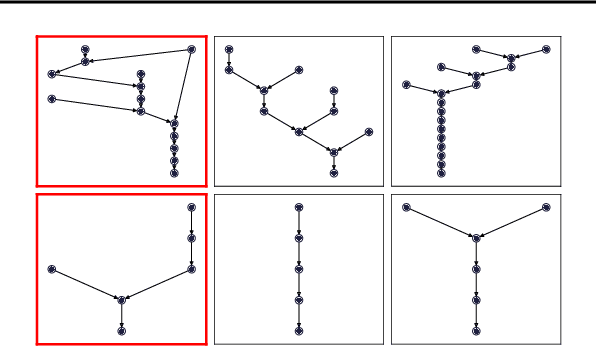
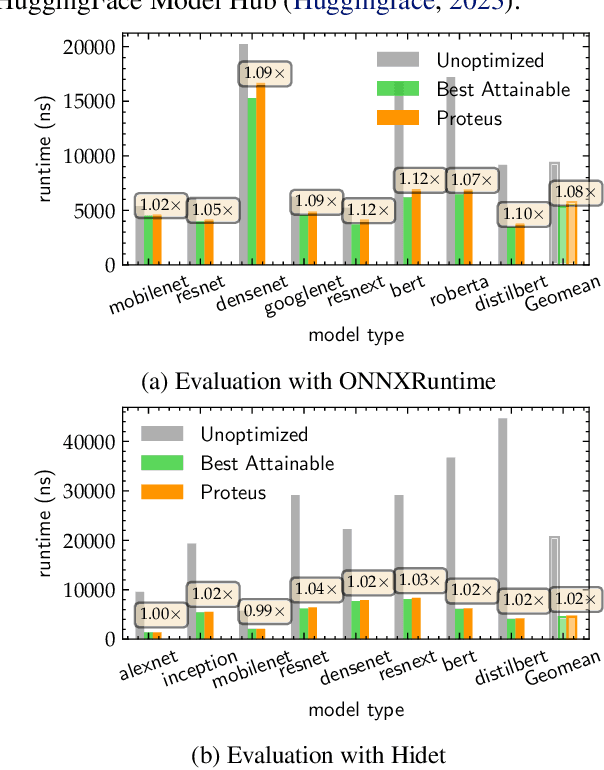
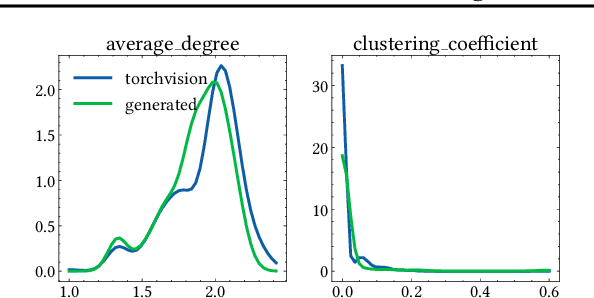
Abstract:Deep learning (DL) models have revolutionized numerous domains, yet optimizing them for computational efficiency remains a challenging endeavor. Development of new DL models typically involves two parties: the model developers and performance optimizers. The collaboration between the parties often necessitates the model developers exposing the model architecture and computational graph to the optimizers. However, this exposure is undesirable since the model architecture is an important intellectual property, and its innovations require significant investments and expertise. During the exchange, the model is also vulnerable to adversarial attacks via model stealing. This paper presents Proteus, a novel mechanism that enables model optimization by an independent party while preserving the confidentiality of the model architecture. Proteus obfuscates the protected model by partitioning its computational graph into subgraphs and concealing each subgraph within a large pool of generated realistic subgraphs that cannot be easily distinguished from the original. We evaluate Proteus on a range of DNNs, demonstrating its efficacy in preserving confidentiality without compromising performance optimization opportunities. Proteus effectively hides the model as one alternative among up to $10^{32}$ possible model architectures, and is resilient against attacks with a learning-based adversary. We also demonstrate that heuristic based and manual approaches are ineffective in identifying the protected model. To our knowledge, Proteus is the first work that tackles the challenge of model confidentiality during performance optimization. Proteus will be open-sourced for direct use and experimentation, with easy integration with compilers such as ONNXRuntime.
Accelerating Graph Neural Networks on Real Processing-In-Memory Systems
Feb 26, 2024



Abstract:Graph Neural Networks (GNNs) are emerging ML models to analyze graph-structure data. Graph Neural Network (GNN) execution involves both compute-intensive and memory-intensive kernels, the latter dominates the total time, being significantly bottlenecked by data movement between memory and processors. Processing-In-Memory (PIM) systems can alleviate this data movement bottleneck by placing simple processors near or inside to memory arrays. In this work, we introduce PyGim, an efficient ML framework that accelerates GNNs on real PIM systems. We propose intelligent parallelization techniques for memory-intensive kernels of GNNs tailored for real PIM systems, and develop handy Python API for them. We provide hybrid GNN execution, in which the compute-intensive and memory-intensive kernels are executed in processor-centric and memory-centric computing systems, respectively, to match their algorithmic nature. We extensively evaluate PyGim on a real-world PIM system with 1992 PIM cores using emerging GNN models, and demonstrate that it outperforms its state-of-the-art CPU counterpart on Intel Xeon by on average 3.04x, and achieves higher resource utilization than CPU and GPU systems. Our work provides useful recommendations for software, system and hardware designers. PyGim will be open-sourced to enable the widespread use of PIM systems in GNNs.
The Synergy of Speculative Decoding and Batching in Serving Large Language Models
Oct 28, 2023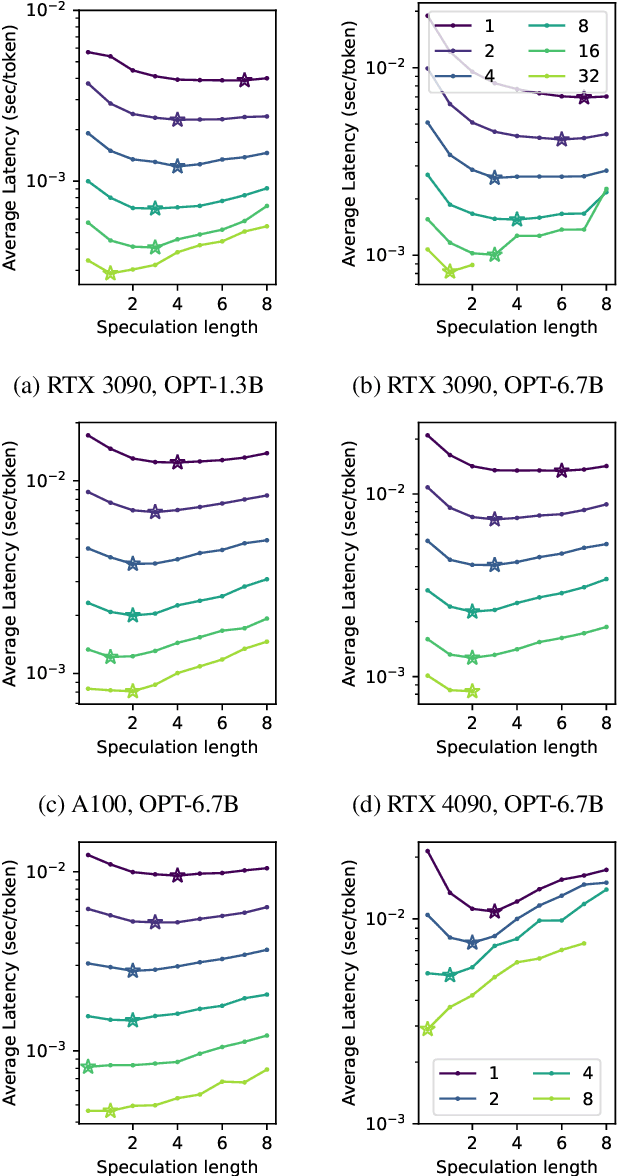
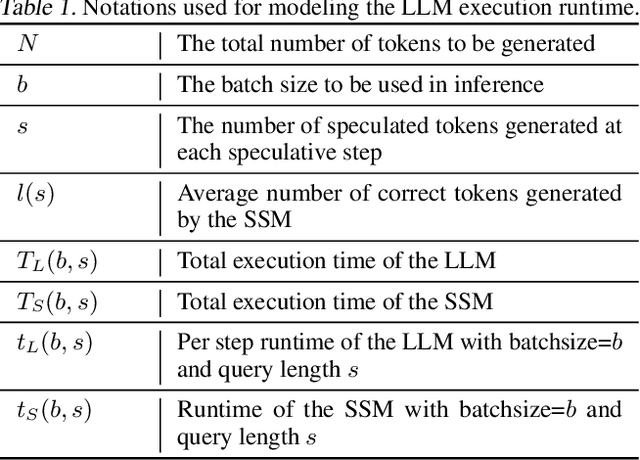
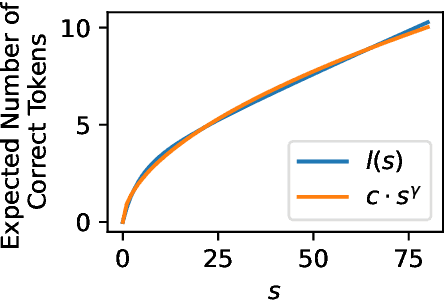
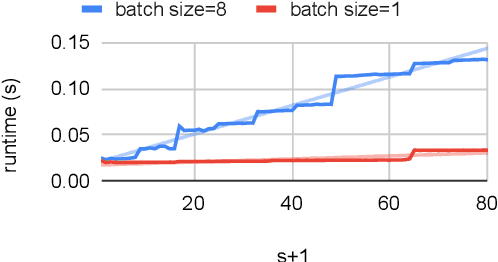
Abstract:Large Language Models (LLMs) like GPT are state-of-the-art text generation models that provide significant assistance in daily routines. However, LLM execution is inherently sequential, since they only produce one token at a time, thus incurring low hardware utilization on modern GPUs. Batching and speculative decoding are two techniques to improve GPU hardware utilization in LLM inference. To study their synergy, we implement a prototype implementation and perform an extensive characterization analysis on various LLM models and GPU architectures. We observe that the optimal speculation length depends on the batch size used. We analyze the key observation and build a quantitative model to explain it. Based on our analysis, we propose a new adaptive speculative decoding strategy that chooses the optimal speculation length for different batch sizes. Our evaluations show that our proposed method can achieve equal or better performance than the state-of-the-art speculation decoding schemes with fixed speculation length.
 Add to Chrome
Add to Chrome Add to Firefox
Add to Firefox Add to Edge
Add to Edge